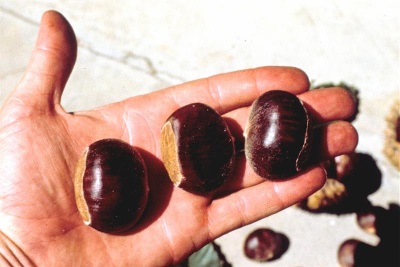 While a lot of folks plant Dunstan Chestnuts to feed and attract deer, many also want to take advantage of the fruits of their labor more directly, by harvesting some of the chestnuts they grow. Here are a few tips for harvesting your Dunstan Chestnuts.
While a lot of folks plant Dunstan Chestnuts to feed and attract deer, many also want to take advantage of the fruits of their labor more directly, by harvesting some of the chestnuts they grow. Here are a few tips for harvesting your Dunstan Chestnuts.
Dunstan Chestnuts ripen in early September in the deep South, mid September in central states and October in northern states. Because most of the nut growth occurs in the last month before harvest, sub-optimal conditions (enough moisture or an early freeze) can affect the crop. Harvest typically lasts 4-6 weeks depending on variety and climate.
Traditional harvest is done by hand, and because chestnuts are borne in spiny husks called burrs, heavy gloves are a necessity. In commercial orchards, pickers are often paid by the pound or by the bucket as an incentive to work quickly, and to control costs. Some growers offer this as a fundraiser to schools or church groups. Private landowners may want to make it a weekend social event, letting friends, family and/or neighbors share in the work and the bounty.
In warmer climates nuts should be harvested daily, if possible, to lower desiccation and spoilage of the nuts in the field. In northern areas nuts can be harvested less frequently.
However, without fencing, predation by deer and other animals can reduce harvest quantities. That’s a bane to commercial orchardists but can be a boom for private landowners who are also interested in attracting and feeding wildlife.
Chestnut Hill Outdoors is more than just a nursery. In order to ensure you receive the maximum benefit from their products, they also provide sound advice and instruction on proper planting and care. For more on Chestnut Hill Outdoors products and how to care for them, visit ChestnutHillOutdoors.com, or call (855) 386-7826.
